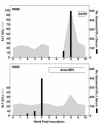In vitro replication of hepatitis E virus (HEV) genomes and of an HEV replicon expressing green fluorescent protein
- PMID: 15078965
- PMCID: PMC387676
- DOI: 10.1128/jvi.78.9.4838-4846.2004
In vitro replication of hepatitis E virus (HEV) genomes and of an HEV replicon expressing green fluorescent protein
Abstract
Hepatitis E virus (HEV) RNA replication occurred in seven of nine primate cell cultures transfected with in vitro transcripts of an infectious cDNA clone. Cell-to-cell spread did not occur in cell cultures, but rhesus monkeys inoculated with lysates of HEV-transfected PLC/PRF/5 and Huh-7 cells became infected with HEV. A replicon with the ORF2 and ORF3 genes deleted and replaced with the green fluorescent protein gene also replicated in the same primate cells that supported the replication of the full-length genome. Fluorescence-activated cell sorter analysis confirmed that the 7mG cap structure was critical for efficient infectivity, although replication could be initiated at a very low level in its absence. HEV virions were also able to infect a limited number of cells of certain lines.
Figures








References
-
- Agrawal, S., D. Gupta, and S. K. Panda. 2001. The 3′ end of hepatitis E virus (HEV) genome binds specifically to the viral RNA-dependent RNA polymerase (RdRp). Virology 282:87-101. - PubMed
-
- Arankalle, V. A., M. V. Joshi, A. M. Kulkarni, S. S. Gandhe, L. P. Chobe, S. S. Rautmare, A. C. Mishra, and V. S. Padbidri. 2001. Prevalence of anti-hepatitis E virus antibodies in different Indian animal species. J. Viral Hepat. 8:223-227. - PubMed
-
- Arankalle, V. A., S. A. Tsarev, M. S. Chadha, D. W. Alling, S. U. Emerson, K. Banerjee, and R. H. Purcell. 1995. Age-specific prevalence of antibodies to hepatitis A and E viruses in Pune, India, 1982 and 1992. J. Infect. Dis. 171:447-450. - PubMed
-
- Emerson, S. U., and R. H. Purcell. 2003. Hepatitis E virus. Rev. Med. Virol. 13:145-154. - PubMed
-
- Emerson, S. U., M. Zhang, X. J. Meng, H. Nguyen, M. St Claire, S. Govindarajan, Y. K. Huang, and R. H. Purcell. 2001. Recombinant hepatitis E virus genomes infectious for primates: importance of capping and discovery of a cis-reactive element. Proc. Natl. Acad. Sci. USA 98:15270-15275. - PMC - PubMed
Publication types
MeSH terms
Substances
Grants and funding
LinkOut - more resources
Full Text Sources
Other Literature Sources
Miscellaneous

